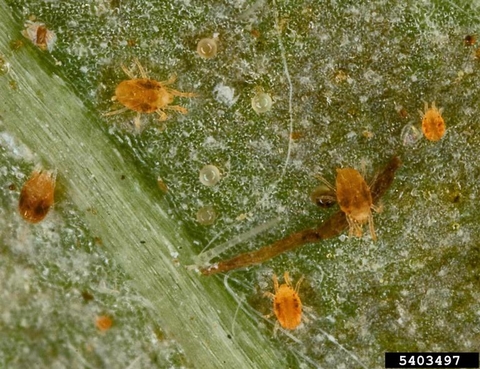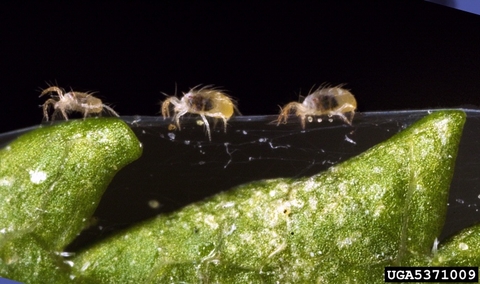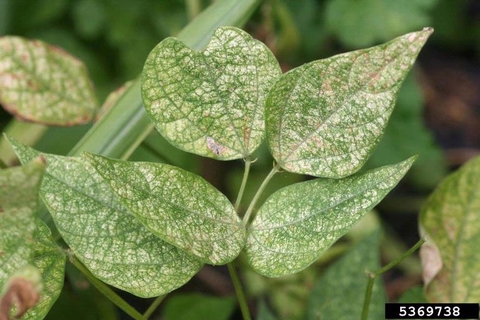Identification of Twospotted spider mites
Adults (Figures 1 and 2)
- Small size (0.05 cm long) with 8 legs.
- Body is yellowish orange and somewhat translucent. One black spot on each side of the body (hence the "twospotted" part of the name).
Eggs (Figure 1)
Eggs are clear, round, and shiny. They are difficult to see and are most often on webbing.
Nymphs
- Nymphs are similar to adults, but smaller.
Natural history
Twospotted spider mites overwinter as eggs on plant debris. Egg to adult development takes one to two weeks depending on temperature, with individuals developing through larval and nymphal stages before becoming adults. Multiple generations occur per year. Under high temperatures (>90°F) and dry conditions, twospotted spider mite infestations can increase rapidly over short periods of time.
Twospotted spider mites establish colonies on the undersides of leaves and produce webbing over infested leaf and stem surfaces (Figure 1b). This webbing is what gives them the "spider" part of the name. Infestations generally begin low in the canopy and move upward as the infestations progress.
Impacts
Twospotted spider mites feed on soybean leaves and cause injury by sucking contents out of leaf cells. The plant cells injured by mite feeding appear as white or yellow spots (stippling) on leaves and are usually most abundant on the undersides of leaves (Figure 2).
In severe infestations, infested leaves will turn yellow to tan, or sometimes bronze-colored, and may drop off plants. Infestations can reduce yield.
Damage is often first noticed on field borders as mites disperse into fields from surrounding vegetation. This movement is often greater in the direction of prevailing winds, because the mites release silken threads which allow them to be carried on the wind ("ballooning").
Scouting and management
A magnifying lens can be useful for seeing this small-sized pest. Risk of infestation is greatest under drought conditions. Since infestations are typically first noticed in field edges, initial scouting can focus on these areas; particularly edges near alfalfa, grassy ditches and other perennial vegetation.
Scouting
Beginning at the edge of the field, examine the undersides of leaves to determine if twospotted spider mites and/or webbing are present. If present, move farther into the field and examine two plants at each of twenty locations spread throughout the field.
Treatment thresholds
Once twospotted spider mites are found, use the following scale developed by Potter and Ostlie (1988) to determine if an insecticide application is needed:
- No spider mites or injury observed.
- Minor stippling on lower leaves, no premature yellowing observed.
- Stippling common on lower leaves, small areas on scattered plants with yellowing.
- Heavy stippling on lower leaves with some stippling progressing into middle canopy. Mites present in middle canopy with scattered colonies in upper canopy. Lower leaf yellowing common and some lower leaf loss. (Spray threshold)
- Lower leaf yellowing readily apparent. Leaf drop common. Stippling, webbing and mites common in middle canopy. Mites and minor stippling present in upper canopy. (Economic loss)
- Lower leaf loss common, yellowing or browning moving up plant into middle canopy, stippling and distortion of upper leaves common. Mites present in high levels in middle and lower canopy.
This rating scale will help you assess mite infestation and time insecticide application to protect the upper two-thirds of the plant canopy. Because populations can increase rapidly, scouting should be repeated every four to five days.
Treatment
Several insecticides (e.g., dimethoate and bifenthrin) also act as miticides and are labeled for controlling twospotted spider mites. However, beware that some insecticides have been known to worsen infestations by causing the populations to increase ("flare"). As with any pesticide use, follow directions on the product label.
Reviewed in 2022




